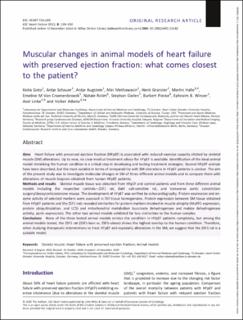| dc.contributor.author | Goto, Keita | |
| dc.contributor.author | Schauer, Antje | |
| dc.contributor.author | Augstein, Antje | |
| dc.contributor.author | Methawasin, Mei | |
| dc.contributor.author | Granzier, Henk | |
| dc.contributor.author | Halle, Martin | |
| dc.contributor.author | Craenenbroeck, Emeline M Van | |
| dc.contributor.author | Rolim, Natale Pinheiro Lage | |
| dc.contributor.author | Gielen, Stephan | |
| dc.contributor.author | Pieske, Burkert | |
| dc.contributor.author | Winzer, Ephraim B. | |
| dc.contributor.author | Linke, Axel | |
| dc.contributor.author | Adams, Volker | |
| dc.date.accessioned | 2023-01-12T09:55:45Z | |
| dc.date.available | 2023-01-12T09:55:45Z | |
| dc.date.created | 2022-03-24T21:58:33Z | |
| dc.date.issued | 2021 | |
| dc.identifier.citation | ESC Heart Failure. 2021, 8 (1), 139-150. | en_US |
| dc.identifier.issn | 2055-5822 | |
| dc.identifier.uri | https://hdl.handle.net/11250/3042928 | |
| dc.description.abstract | Aims
Heart failure with preserved ejection fraction (HFpEF) is associated with reduced exercise capacity elicited by skeletal muscle (SM) alterations. Up to now, no clear medical treatment advice for HFpEF is available. Identification of the ideal animal model mimicking the human condition is a critical step in developing and testing treatment strategies. Several HFpEF animals have been described, but the most suitable in terms of comparability with SM alterations in HFpEF patients is unclear. The aim of the present study was to investigate molecular changes in SM of three different animal models and to compare them with alterations of muscle biopsies obtained from human HFpEF patients.
Methods and results
Skeletal muscle tissue was obtained from HFpEF and control patients and from three different animal models including the respective controls—ZSF1 rat, Dahl salt-sensitive rat, and transverse aortic constriction surgery/deoxycorticosterone mouse. The development of HFpEF was verified by echocardiography. Protein expression and enzyme activity of selected markers were assessed in SM tissue homogenates. Protein expression between SM tissue obtained from HFpEF patients and the ZSF1 rats revealed similarities for protein markers involved in muscle atrophy (MuRF1 expression, protein ubiquitinylation, and LC3) and mitochondrial metabolism (succinate dehydrogenase and malate dehydrogenase activity, porin expression). The other two animal models exhibited far less similarities to the human samples.
Conclusions
None of the three tested animal models mimics the condition in HFpEF patients completely, but among the animal models tested, the ZSF1 rat (ZSF1-lean vs. ZSF1-obese) shows the highest overlap to the human condition. Therefore, when studying therapeutic interventions to treat HFpEF and especially alterations in the SM, we suggest that the ZSF1 rat is a suitable model. | en_US |
| dc.language.iso | eng | en_US |
| dc.publisher | John Wiley & Sons Ltd | en_US |
| dc.rights | Navngivelse-Ikkekommersiell 4.0 Internasjonal | * |
| dc.rights.uri | http://creativecommons.org/licenses/by-nc/4.0/deed.no | * |
| dc.title | Muscular changes in animal models of heart failure with preserved ejection fraction: what comes closest to the patient? | en_US |
| dc.title.alternative | Muscular changes in animal models of heart failure with preserved ejection fraction: what comes closest to the patient? | en_US |
| dc.type | Peer reviewed | en_US |
| dc.type | Journal article | en_US |
| dc.description.version | publishedVersion | en_US |
| dc.source.pagenumber | 139-150 | en_US |
| dc.source.volume | 8 | en_US |
| dc.source.journal | ESC Heart Failure | en_US |
| dc.source.issue | 1 | en_US |
| dc.identifier.doi | 10.1002/ehf2.13142 | |
| dc.identifier.cristin | 2012418 | |
| cristin.ispublished | true | |
| cristin.fulltext | original | |
| cristin.qualitycode | 1 | |

